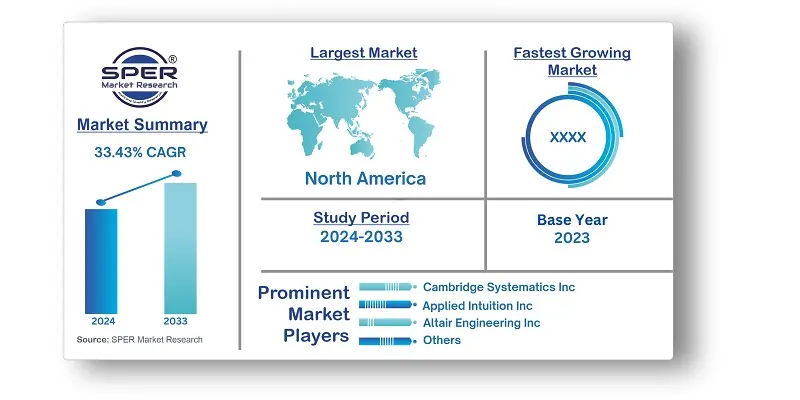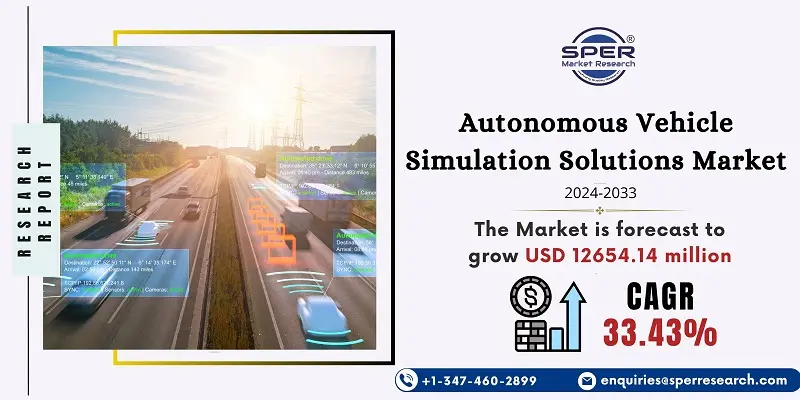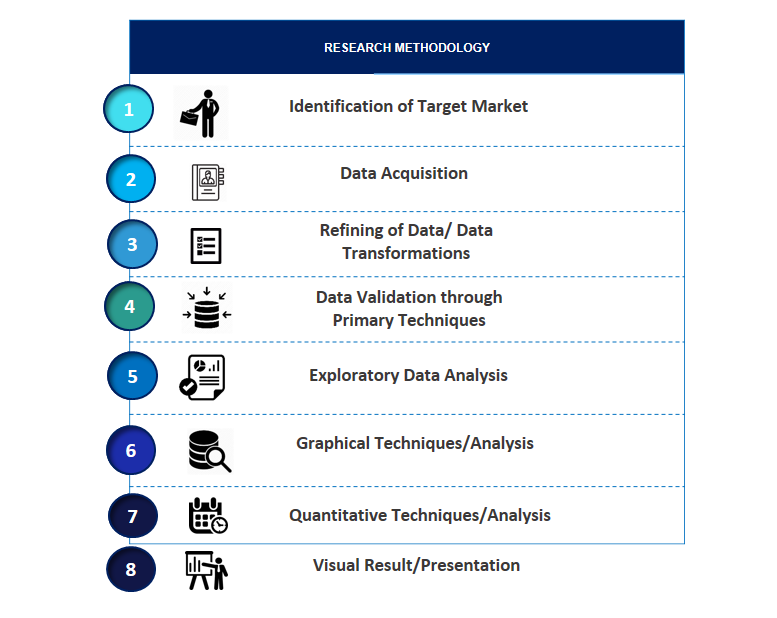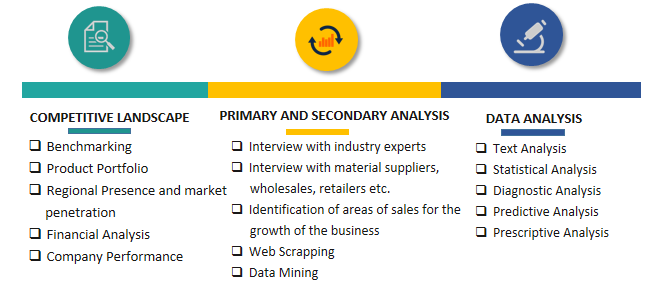
Autonomous Vehicle Simulation Solutions Market Growth, Size, Trends, Share and Future Outlook
Autonomous Vehicle Simulation Solutions Market Size- By Type, By Deployment, By Application- Regional Outlook, Competitive Strategies and Segment Forecast to 2033
| Published: Aug-2024 | Report ID: AMIN24188 | Pages: 1 - 245 | Formats*: |
| Category : Automotive & Transportation | |||
- June 2020: Waymo and Lyft announced in that they will be working together on self-driving technology.
- July 2020: Ford and Volkswagen declared their collaboration to create self-driving cars.
- August 2020: Toyota and Uber declared their collaboration to create self-driving vehicles.
- July 2020: Cruise Automation debuted its self-driving car service in San Francisco


| Report Metric | Details |
| Market size available for years | 2020-2033 |
| Base year considered | 2023 |
| Forecast period | 2024-2033 |
| Segments covered | By Type, By Deployment, By Application |
| Regions covered | North America, Asia-Pacific, Latin America, Middle East & Africa and Europe |
| Companies Covered | Altair Engineering Inc, Applied Intuition Inc, Cambridge Systematics Inc, Calspan Systems Corporation, Green Hills Software LLC, IPG Automotive GmbH, LHP Engineering Solutions, MSC Software Corporation, NVIDIA Corporation. |
- Automotive Manufacturers
- Technology Providers and AI Companies
- Research Institutions and Universities
- Government and Regulatory Bodies
- Logistics and Transportation Companies
- Public Transportation Authorities
- Agricultural Equipment Manufacturers
- Construction and Mining Companies
- Insurance Companies
- Venture Capitalists and Investors
| By Type: |
|
| By Deployment: |
|
| By Application: |
|
- Global Autonomous Vehicle Simulation Solutions Market Size (FY’2024-FY’2033)
- Overview of Global Autonomous Vehicle Simulation Solutions Market
- Segmentation of Global Autonomous Vehicle Simulation Solutions Market by Type (Services, Software)
- Segmentation of Global Autonomous Vehicle Simulation Solutions Market by Deployment (On-Premises, Cloud)
- Segmentation of Global Autonomous Vehicle Simulation Solutions Market by Application (Automotive Original Equipment Manufacturers, Autonomous Driving Technology Development Company, Component Manufacturer, University and Research Center, Other Applications)
- Statistical Snap of Global Autonomous Vehicle Simulation Solutions Market
- Expansion Analysis of Global Autonomous Vehicle Simulation Solutions Market
- Problems and Obstacles in Global Autonomous Vehicle Simulation Solutions Market
- Competitive Landscape in the Global Autonomous Vehicle Simulation Solutions Market
- Impact of COVID-19 and Demonetization on Global Autonomous Vehicle Simulation Solutions Market
- Details on Current Investment in Global Autonomous Vehicle Simulation Solutions Market
- Competitive Analysis of Global Autonomous Vehicle Simulation Solutions Market
- Prominent Players in the Global Autonomous Vehicle Simulation Solutions Market
- SWOT Analysis of Global Autonomous Vehicle Simulation Solutions Market
- Global Autonomous Vehicle Simulation Solutions Market Future Outlook and Projections (FY’2024-FY’2033)
- Recommendations from Analyst
1.1. Scope of the report1.2. Market segment analysis
2.1. Research data source
2.1.1. Secondary Data2.1.2. Primary Data2.1.3. SPER’s internal database2.1.4. Premium insight from KOL’s
2.2. Market size estimation
2.2.1. Top-down and Bottom-up approach
2.3. Data triangulation
4.1. Driver, Restraint, Opportunity and Challenges analysis
4.1.1. Drivers4.1.2. Restraints4.1.3. Opportunities4.1.4. Challenges
4.2. COVID-19 Impacts of the Global Autonomous Vehicle Simulation Solutions Market.
5.1. SWOT Analysis
5.1.1. Strengths5.1.2. Weaknesses5.1.3. Opportunities5.1.4. Threats
5.2. PESTEL Analysis
5.2.1. Political Landscape5.2.2. Economic Landscape5.2.3. Social Landscape5.2.4. Technological Landscape5.2.5. Environmental Landscape5.2.6. Legal Landscape
5.3. PORTER’s Five Forces
5.3.1. Bargaining power of suppliers5.3.2. Bargaining power of buyers5.3.3. Threat of Substitute5.3.4. Threat of new entrant5.3.5. Competitive rivalry
5.4. Heat Map Analysis
6.1. Global Autonomous Vehicle Simulation Solutions Market Manufacturing Base Distribution, Sales Area, Product Type6.2. Mergers & Acquisitions, Partnerships, Product Launch, and Collaboration in Global Autonomous Vehicle Simulation Solutions Market
7.1. Global Autonomous Vehicle Simulation Solutions Market Size, Share and Forecast, By Type, 2020-20267.2. Global Autonomous Vehicle Simulation Solutions Market Size, Share and Forecast, By Type, 2027-20337.3. Services7.4. Software
8.1. Global Autonomous Vehicle Simulation Solutions Market Size, Share and Forecast, By Deployment, 2020-20268.2. Global Autonomous Vehicle Simulation Solutions Market Size, Share and Forecast, By Deployment, 2027-20338.3. On-Premises8.4. Cloud
9.1. Global Autonomous Vehicle Simulation Solutions Market Size, Share and Forecast, By Application, 2020-20269.2. Global Autonomous Vehicle Simulation Solutions Market Size, Share and Forecast, By Application, 2027-20339.3. Automotive Original Equipment Manufacturers9.4. Autonomous Driving Technology Development Company9.5. Component Manufacturer9.6. University And Research Centre9.7. Other Applications
10.1. Global Autonomous Vehicle Simulation Solutions Market Size and Market Share
11.1. Global Autonomous Vehicle Simulation Solutions Market Size and Market Share By Region (2020-2026)11.2. Global Autonomous Vehicle Simulation Solutions Market Size and Market Share By Region (2027-2033)11.3. Asia-Pacific
11.3.1. Australia11.3.2. China11.3.3. India11.3.4. Japan11.3.5. South Korea11.3.6. Rest of Asia-Pacific
11.4. Europe
11.4.1. France11.4.2. Germany11.4.3. Italy11.4.4. Spain11.4.5. United Kingdom11.4.6. Rest of Europe
11.5. Middle East and Africa
11.5.1. Kingdom of Saudi Arabia11.5.2. United Arab Emirates11.5.3. Qatar11.5.4. South Africa11.5.5. Egypt11.5.6. Morocco11.5.7. Nigeria11.5.8. Rest of Middle-East and Africa
11.6. North America
11.6.1. Canada11.6.2. Mexico11.6.3. United States
11.7. Latin America
11.7.1. Argentina11.7.2. Brazil11.7.3. Rest of Latin America
12.1. ALTAIR ENGINEERING INC
12.1.1. Company details12.1.2. Financial outlook12.1.3. Product summary12.1.4. Recent developments
12.2. APPLIED INTUITION INC
12.2.1. Company details12.2.2. Financial outlook12.2.3. Product summary12.2.4. Recent developments
12.3. CAMBRIDGE SYSTEMATICS INC.
12.3.1. Company details12.3.2. Financial outlook12.3.3. Product summary12.3.4. Recent developments
12.4. CALSPAN SYSTEMS CORPORATION
12.4.1. Company details12.4.2. Financial outlook12.4.3. Product summary12.4.4. Recent developments
12.5. GREEN HILLS SOFTWARE LLC
12.5.1. Company details12.5.2. Financial outlook12.5.3. Product summary12.5.4. Recent developments
12.6. IPG AUTOMOTIVE GMBH
12.6.1. Company details12.6.2. Financial outlook12.6.3. Product summary12.6.4. Recent developments
12.7. LHP ENGINEERING SOLUTIONS
12.7.1. Company details12.7.2. Financial outlook12.7.3. Product summary12.7.4. Recent developments
12.8. MSC SOFTWARE CORPORATION
12.8.1. Company details12.8.2. Financial outlook12.8.3. Product summary12.8.4. Recent developments
12.9. NVIDIA CORPORATION
12.9.1. Company details12.9.2. Financial outlook12.9.3. Product summary12.9.4. Recent developments
12.10. Others
SPER Market Research’s methodology uses great emphasis on primary research to ensure that the market intelligence insights are up to date, reliable and accurate. Primary interviews are done with players involved in each phase of a supply chain to analyze the market forecasting. The secondary research method is used to help you fully understand how the future markets and the spending patterns look likes.
The report is based on in-depth qualitative and quantitative analysis of the Product Market. The quantitative analysis involves the application of various projection and sampling techniques. The qualitative analysis involves primary interviews, surveys, and vendor briefings. The data gathered as a result of these processes are validated through experts opinion. Our research methodology entails an ideal mixture of primary and secondary initiatives.



Frequently Asked Questions About This Report
PLACE AN ORDER
Year End Discount
Sample Report
Pre-Purchase Inquiry
NEED CUSTOMIZATION?
Request CustomizationCALL OR EMAIL US
100% Secure Payment






Related Reports
Our Global Clients
Our data-driven insights have influenced the strategy of 200+ reputed companies across the globe.




















